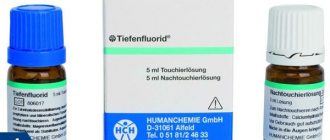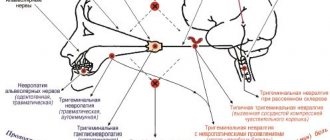Diffuse pulpitis is an inflammation of the pulp that occurs as a result of advanced caries or an incorrectly placed filling. It is characterized by prolonged attacks of pain, occurring mainly at night. Untreated pulpitis threatens the death of the pulp and the development of periodontitis. After you contact our clinic, certified dentists will conduct an examination, diagnosis and determine further stages of treatment. If you contact us in a timely manner, you will end up with a normally functioning tooth that will last for a long time.
Symptoms of acute tooth pulpitis
All types of pulpitis have one common feature: damage to the pulp - connective tissue with a large number of microvessels and nerves. It is the presence of a large number of nerve endings that explains the fact that the disease is almost always accompanied by severe pain. Acute pulpitis is considered a signal that pathogenic bacteria have entered the tooth cavity and caused inflammation. Despite the fact that this form is often the initial stage of pulp damage, it causes a number of very unpleasant sensations in the patient from the very beginning.
List of characteristic features
- Sudden attacks of acute pain (on average 10–20 minutes), worsening at night and usually subsiding during the day.
- Reaction to stimuli (usually hot and cold).
- Painful sensations can be localized both within the tooth and can be felt in the temples, ears, and even in healthy teeth (in the second case, these are symptoms of diffuse pulpitis).
The average duration of acute pulpitis is about two weeks. After this period, the disease usually acquires a chronic stage. Due to the gradual destruction of nerve fibers, the pain becomes aching, less pronounced, but longer lasting. Of course, acute pulpitis does not occur on its own, but is a consequence of bacterial activity.
Clinical manifestations
Treatment of diffuse pulpitis
prescribed after the diagnosis has been correctly made, and an important role in this is played by symptoms that make it possible to correctly identify the disease and differentiate it from others. Clinical manifestations of diffuse pulpitis can be divided into two categories: symptoms characteristic of acute pulpitis, and symptoms characteristic of the diffuse form.
| Symptoms of acute pulpitis | Symptoms of diffuse pulpitis |
|
|
In the first 24–48 hours, the patient suffers from pain that occurs without exposure to external stimuli. The “light” intervals between them are quite long, but exposure to cold leads to the development of pain symptoms. As the disease progresses, pain-free intervals become shorter and shorter. Often the pain does not go away completely, but subsides for a while. During such periods, thermal effects cause new attacks, and cold, on the contrary, can calm them down due to the fact that under its influence the blood vessels narrow. The pain radiates to the occipital and temporal region, as well as to the ears. The acute phase can last from 48 hours to 14 days, after which the disease becomes chronic.
Causes of acute pulpitis
- Complications of caries. Neglected or incompletely cured caries leads to the penetration of streptococci into the pulp through the dentin tubules - bacteria that have an acid-forming function and thereby create the foundation for the development of infection.
- Injuries of a mechanical or chemical nature that violate the integrity of the tooth. Without a protective layer of enamel and dentin, the pulp becomes extremely vulnerable to bacteria and the effects of the external environment.
- Gum disease in which infection spreads through open periodontal pockets.
- Unsuccessful dental treatment (infection, damage to tooth tissue, etc.).
ETIOLOGY OF PULPITIS
Pulpitis can have several causes. Basic:
- penetration of infection;
- various damage to the surface of the teeth: chips, cracks, crown fracture;
- irritation during caries treatment and filling.
The inflammatory process of nerves and vessels in the pulp can begin as a result of streptococci and staphylococci entering the pulp chamber. This occurs during medical intervention: grinding a tooth for a crown, filling, caries treatment. Failure to comply with the technology and inaccurate actions of the physician lead to overheating of the pulp and its inflammation.
Another reason may be the predisposition of the teeth to wear or the breakage of one of them. The disease can also develop due to caries.
Acute diffuse pulpitis
Usually it is the next stage of focal pulpitis (sometimes the peak form of chronic) and appears on the third or fourth day. With diffuse pulpitis, inflammation affects both the coronal and root parts of the pulp. The pain is paroxysmal and long-lasting, with periods of relief being rare. The pain is often radiating and radiates to various parts of the head. The fabric begins to become saturated with exudate.
Some sources also highlight acute fibrous pulpitis, but this is not entirely true. Fibrous pulpitis is a form of chronic; acute fibrous pulpitis is also not a completely correct term. It is a chronic complication of diffuse pulpitis. When gangrenous, extensive tissue necrosis occurs and the tooth often takes on a characteristic gray tint.
Deep caries
Chronic
Chronic deep caries in the vast majority of cases occurs with mild pain in the tooth. They occur mainly due to mechanical irritation of the bottom of the carious cavity (for example, food or dental instruments). Often the disease is not accompanied by complaints at all. The patient may be concerned about cosmetic defects and changes in tooth color.
Spicy
If deep caries has an acute course, all symptoms appear quickly and are mainly associated with pain that occurs after tooth contact with sweet, sour, salty foods or when eating too hot or cold food. Pain may also occur when hard pieces of food enter the cavity. This form is characterized by a gradual (within a few seconds) disappearance of pain.
On the front tooth
Carious lesions of incisors are less common than chewing teeth. The disease is promoted by poor hygiene and crowded teeth, which together worsens the quality of cleaning teeth from plaque and leads to the formation of carious disease. Favorite localizations of carious lesions are contact surfaces (places of contact of the lateral surfaces of the teeth) and the cervical region. Due to the fact that the enamel of the front teeth is quite thin, the carious process quickly reaches the deepest layers of dentin and, without treatment, turns into pulpitis or periodontitis.
On chewing teeth
Caries of chewing teeth occurs in the vast majority of cases. It can be localized in the contact area, in the fissures and in the cervical area.
Fissures are natural depressions and pits located on the chewing surface of molars. They often accumulate food debris, and without proper cleaning, hard dental tissues are destroyed. In children, fissures are especially deep, so fissure caries is common in children.
On a wisdom tooth
Due to their distant location, the figure eights are poorly cleaned of plaque, so caries often forms in them. If the tooth has fully erupted, stands straight and the patient can open his mouth wide, the dentist will try to treat deep caries. However, there are often cases when you have to say goodbye to such a tooth, because it cannot be fully cleaned and sealed.
On baby teeth
Caries in children can appear from the moment the first teeth erupt. They are not yet sufficiently mineralized, so they have thinner and weaker enamel, which is a favorable factor for them to be affected by deep caries.
The opinion that temporary teeth cannot be treated is erroneous, because... Baby teeth must remain in place until they are replaced by permanent teeth, otherwise problems with bite may occur. If they are not treated, the child will experience discomfort, the rudiments of permanent teeth may be damaged, and they will either die and not erupt, or those already affected by caries will erupt.
Secondary deep caries
Secondary caries develops in cases where the filling on the tooth is old (or not tightly installed) and is no longer tightly adjacent to the edges of the previously treated cavity. Oral fluid and bacteria seep under it, which triggers the process of tooth destruction.
The tooth itself darkens under the filling, which indicates that caries is progressing. In addition to color changes, the presence of the disease can be determined using x-ray diagnostics. The secondary process will be visible as a focus of clearing under the contrast filling.
Diagnosis of acute pulpitis
Diagnosis of acute pulpitis includes several stages. First, the doctor conducts a visual examination of the oral cavity: if the tooth has a carious cavity or is injured, and the patient complains of acute pain, then there is a high probability that we are talking about pulpitis. Acute and chronic pulpitis have quite significant differences, so visual diagnosis alone is impossible.
Each of the forms of acute pulpitis (they will be discussed later) has its own manifestations and characteristics. To identify the type and stage of the disease, specialists resort to x-rays and electroodontic diagnostics (EDD), which determines the reaction of the pulp to electric current. Rheodentography (assessment of the blood supply to the pulp) and a thermal test are also quite often performed. In addition, differential diagnosis of acute pulpitis is necessary in order to make an accurate diagnosis and not confuse pulpitis with other diseases with similar symptoms.
Diagnosis of the disease
Treatment of gangrenous pulpitis is prescribed only after the dentist makes the correct diagnosis. It is very important to be able to distinguish this disease from:
- deep caries;
- chronic fibrous pulpitis;
- apical periodontitis.
A visual examination of the oral cavity by a dentist reveals the following:
- deep carious cavity with softened dentin;
- open dental cavity;
- grayish coating on the upper layers of the pulp;
- change in the color of the tooth crown.
Probing the pulp can be painful, in contrast to percussion, in which there are practically no pain symptoms.
In addition to a visual examination, the doctor will prescribe:
- X-ray diagnostics;
- electroodontodiagnostics.
Treatment of acute tooth pulpitis
Treatment of caries, pulpitis and acute periodontitis forms the basis of the activities of any dental clinic. It is important for the patient to find a doctor whom he can trust with his health. Below is a table that describes the main types and methods of treating acute dental pulpitis.
Treatment methods for acute pulpitis
✔
Classical technique: tooth depulpation, removal of affected tissue and filling.
✔
Biological method of treating acute forms of pulpitis with partial preservation of the pulp. It is carried out in two visits. The first stage involves preparing the tooth, applying therapeutic and insulating spacers, and installing a temporary filling. At the second appointment, a visual inspection and fixation of the permanent filling is performed. This type of treatment is possible only with minimal inflammation of the pulp and at a young age (up to 26-27 years).
Treatment of acute diffuse pulpitis in the vast majority of cases requires complete removal of the pulp. A biological method with the possibility of preserving part of it is possible in a minimal percentage of cases.
Treatment of pulpitis
There are two directions in the tactics of treating dental pulpitis: biological (conservative) and surgical. In the first case, all medical actions are aimed at quickly and completely eliminating the infectious and inflammatory process in the pulp, as well as restoring its normal functioning. The surgical treatment method involves partial or complete removal of the pulp.
The choice of treatment option is made individually. It depends on the clinical picture of the disease and the results of the patient’s examination.
Thanks to modern developments in dentistry and pharmacology, treating pulpitis is not painful at all. To prevent and eliminate discomfort during treatment procedures, both local anesthesia and general anesthesia can be used. General anesthesia is recommended for those patients who have multiple allergies to drugs for local anesthesia (anesthetics) or severe fear of dental procedures.
Conservative treatment
Conservative treatment is indicated in the initial stages of acute inflammation in the pulp and in the chronic fibrous version of the disease. Therapeutic dentistry methods can be recommended to all young patients, as well as children and adolescents, including those with pulpitis of primary teeth.
Additional criteria for conservative treatment of dental pulpitis are:
- lack of data on periodontitis during a complete examination of the patient;
- duration of the inflammatory process up to three days;
- detection of a carious cavity within the anatomical crown of the tooth.
For drug treatment of pulpitis, combination therapy is prescribed. It includes antibacterial agents, calcium-containing drugs, enzymes and antienzymes, glycosaminoglycans and vitamins. The combined treatment regimen allows not only to destroy pathogenic microorganisms, but also stimulates pulp regeneration. In case of severe pain and inflammation due to pulpitis, antibiotics are prescribed in combination with hormonal agents (glucocorticosteroids). Hormones are used only topically and in short courses of 3-5 days under the strict supervision of a doctor.
In order to ensure maximum interaction of drugs with the inflamed pulp, the carious cavity is first opened. To do this, the oral cavity is thoroughly treated with an antiseptic solution, then the manipulation begins directly. After opening the tooth cavity, the carious cavity is closed with an airtight bandage for several days.
At the next appointment, the affected tooth is again treated using antibacterial and anti-inflammatory agents. Then the doctor closes the carious cavity with a special medicinal paste and a temporary filling. During the third visit, the dentist assesses the condition and vitality of the pulp. The final stage of treatment is the installation of a permanent filling.
Surgery
The surgical treatment method consists of partial or complete removal of the inflamed tooth pulp. Modern techniques make it possible to treat pulpitis in one session and save the healthy pulp as much as possible from removal.
Methods of surgical intervention are varied, but are divided into two large groups: vital and devital. In the first case, the pulp is removed immediately, and in the second, removal is preceded by its destruction (devitalization). For this, various means are used, for example, arsenic preparations.
The main options for surgical procedures for pulpitis:
- vital pulpotomy – partial excision of an area of inflamed pulp followed by drug treatment and filling;
- vital pulpectomy – simultaneous removal of coronal and root pulp;
- devital pulp extirpation - necrosis of the pulp using arsenic or paraformaldehyde paste with its subsequent removal;
- devital pulp amputation – removal of necrotic coronal pulp.
Devital methods are most often used in cases where it is impossible to perform vital surgery.
Prices for biological or surgical treatment of pulpitis largely depend on the extent of the process. Prices for surgical procedures are higher. It is worth noting that the cost of treating pulpitis with a highly qualified doctor, although higher, completely eliminates the possibility of diagnostic and tactical errors in treatment.
Treatment of complicated stages of acute pulpitis
Focal and diffuse pulpitis have their own varieties. The first has serous and purulent forms. Focal acute serous pulpitis often occurs as a complication of caries or during improper treatment of caries. It affects the root part of the pulp, which causes sharp attacks of pain. Diffuse serous acute pulpitis spreads to both the coronal and root parts of the pulp, causing severe swelling, which can develop into phlegmon.
Acute purulent pulpitis (pulp abscess), as the name suggests, is characterized by the accumulation of pus in the pulp chamber, throbbing pain, which can radiate to various parts of the jaw and head (which is why the patient often cannot identify the diseased tooth). For successful treatment, it is necessary to completely remove the pus from the canals, and in most cases the tooth is subsequently killed. Treatment of acute traumatic pulpitis is usually more difficult.
Symptoms that may indicate the development of pulpitis
Knowing the symptoms characteristic of pulpitis will help you promptly suspect the development of this disease and seek treatment for it. The following symptoms will be common to any form of pulpitis:
- Hypersensitivity of the diseased tooth to temperature stimuli;
- Changing the color of the natural enamel coating of the tooth;
- Redness, inflammation of the soft tissues of the oral cavity near the diseased dental unit;
- The appearance of putrid odor from the mouth.
But the main symptom of pulp inflammation will be excruciating pain, which patients describe as shooting, rolling in attacks. The attacks become most intense at night; unpleasant sensations during the initial phases of development are localized in the area of the diseased tooth, and later begin to radiate to different parts of the face, head and even neck. USEFUL TO KNOW: in some cases, pulpitis develops in the tooth without any external manifestations. Moreover, it can at any time turn into periodontitis and periostitis - diseases in which the risk of losing a tooth increases significantly. For timely diagnosis of latent pulpitis and the beginning of its treatment, you should regularly visit the dentist and undergo a preventive examination.
What are the differences from other forms of the disease?
Deep caries is very similar to some forms of the disease, but there are still visible and invisible differences.
Difference from pulpitis
Pulpitis is a complication of advanced caries. The forms of the disease can be distinguished from each other by their characteristic symptoms:
- Defeat. With pulpitis, the nerve is affected; with caries, the nerve remains unharmed.
- Feelings of pain. With pulpitis, pain can occur spontaneously, even without exposure to irritants on the tooth. With caries, pain disappears along with the disappearance of irritants.
- Night sleep. With pulpitis, sleep can be disturbed due to severe pain; with caries, the tooth does not hurt at night.
Difference from average caries
The similarity between the two forms of the disease is that the patient in both forms feels pain from cold, sour or sweet foods. However, with average caries they go away within 1-2 minutes, with deep caries they last longer.
Medium caries is characterized by the fact that in this form the carious lesion does not affect the tooth pulp and does not cause inflammation of the nerve, as in deep caries.









